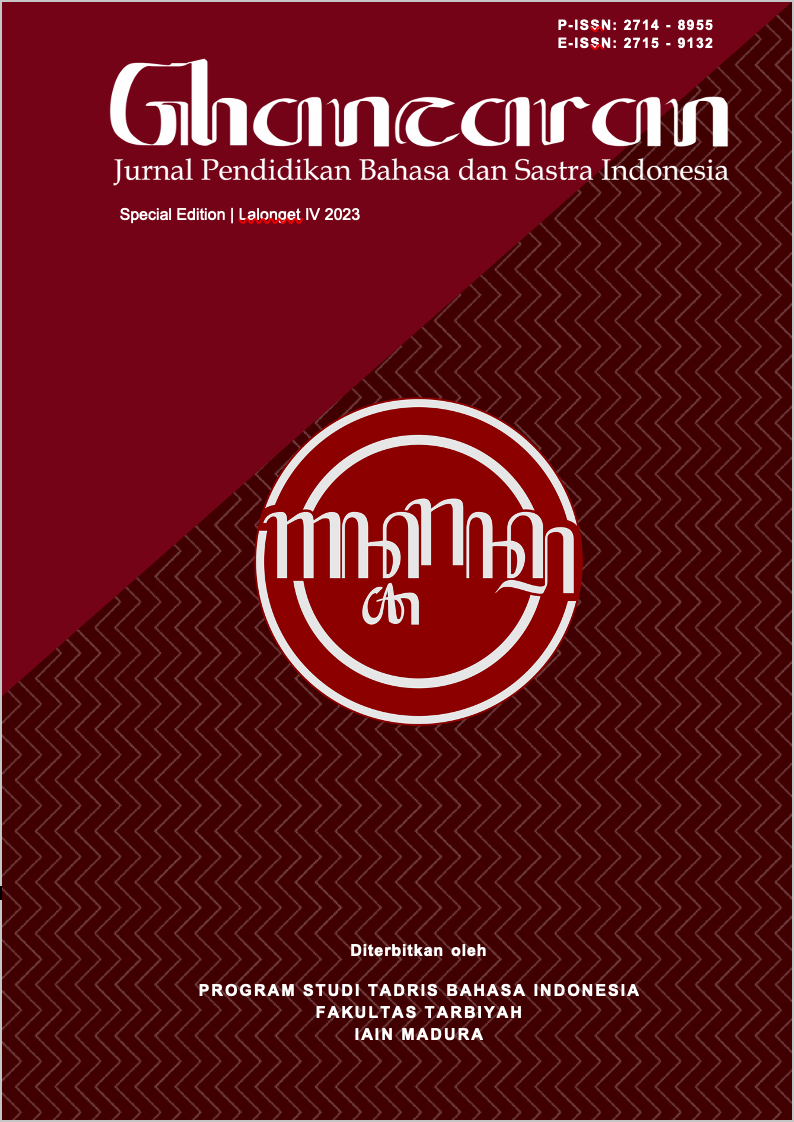Hasil Belajar Teks Eksplanasi Menggunakan Media Audio Visual Youtube pada Siswa kelas XI di MA Sumber Bungur
 Abstract views: 157
,
Abstract views: 157
,
 PDF downloads: 139
PDF downloads: 139
Abstract
Apart from providing entertainment, YouTube media can also be used as a source of knowledge in the field of education. Explanatory text is text that describes the occurrence of a phenomenon so that readers can clearly understand the background of the phenomenon. The aim of this research is to describe the results of learning explanatory texts using YouTube audio-visual media for class XI students at MA Sumber Bungur, Pamekasan. This research is a quantitative type with a quasi-experimental research design using a pre-test post-test control group. The data source is students of class XI IPA 1 and XI IPA 2 MA Sumber Bungur. The sample used in this research used a purportive sampling technique. Data collection techniques used tests and non-tests with expert tests on cognitive, affective and psychomotor aspects. In testing the hypothesis, the researcher used the Independent Sample T-test. The results of this research show that comparing the results of the hypothesis in the post-test with data analysis of learning results from explanatory texts, namely data processing using hypothesis testing (t test) with SPSS 26 produces a value (sig.2 - tailed) at a significance level of 5% (0.05). The learning results of the hypothesis test (t test) show that Ha is accepted and H0 is rejected. Students who use YouTube learning materials on average have better learning outcomes than students who do not use YouTube learning materials. The percentage gain is 96%.
Downloads
References
Dwika Masni, Eva. 2020. “Peningkatan Kemampuan Penalaran dan Komunikasi Statistik Mahasiswa Melalui Pembelajaran Statistik Inferensial Berbasis Proyek dengan Meninjau Gaya Kognitif Mahasiswa.” Pendidikan Matematika 5.
Fahron Setiadi, Erik. 2019. “Youtube Sebagai Sumber Belajar Generasi Milenial.” Journal Of Civic Education 2.
Hawib Hamzah, Syeh. 2012. “Aspek Pengembangan Peserta Didik: Kognitif, Afektif, Psikomotorik.” Dinamika Ilmu 12.
Ilyasa Aghni, Rizqi. 2018. “Fungsi dan Jenis Media Pembelajaran Dalam Pembelajaran Akuntansi.” Pendidikan Akuntansi Indonesia 16.
Kuznetsov, Dmitry, dan Milan Ismangil. 2020. “Youtube as Praxis ? On BreadTube and the Digital Propagation of Socialist Thought.” 18(December 2019):204–18.
Mutaqin, Imam, dan Erni Wijayanti. 2019. “Pelajaran Tematik Madrasah Ibtidaiyah Di Kecamatan Jogoroto Jombang: Universitas Pesantren Tinggi Darul.” 1(2):1–23.
Najihah, Mu, Asep Purwo, Yudi Utomo, dan Alfiyani Nur Safitri. 2023. “Pemanfaatan Youtube untuk Pembelajaran Bahasa Indonesia Materi Teks Eksplanasi di SMP.”
Nur Inah, Ety. 2015. “Peran Komunikasi Dalam Inteeraksi Guru dan Siswa.” Kajian Ilmu Kependidikan 8:150–67.
Nurgiansah, Heru. 2021. Filsafat Pendidikan. Purwokwerto Selatan: CV. Pena Persada.
Nurhayati, Ifa, Muhammad Khumaedi, dan Heri Yudiono. 2018. “The Effectiveness of the Use of Video Media on Learning on the Competence of Scalp and Hair Care of Vocational High School Students of Beauty Department.” Journal of Vocational and Career Education 3(1):66–72.
Nurrita, Teni. 2018. “Pengembangan Media Pembelajaran Untuk Meningkatkan Hasil Belajar Siswa.” Ilmu-Ilmu Al-Quran, Hadist, Syari’ah dan Tarbiyah 03(01):184.
Otiani, Ifni. 2017. “Kreativitas Guru dalam Meningkatkan Motivasi Belajar Peserta Didik.” Kependidikan 5.
Pamungkas, Wahyu Agung Dwi, dan Henny Dewi Koeswanti. 2022. “Penggunaan Media Pembelajaran Video Terhadap Hasil Belajar Siswa Sekolah Dasar.” Jurnal Ilmiah Pendidikan Profesi Guru 4(3):346–54.
Purwanto. 2009. Evaluasi Hasil Belajar. Yogyakarta: Pustaka Belajar.
Rahayu, Ajeng. 2013. Bahasa Indonesia. Jawa Tengah: Viva Pakarindo.
Rizki Wulandari, Amalia, Masturi, dan Fina Fakhriyah. 2021. “Pengaruh Media Pembelajaran Berbasis Yotube Terhadap Hasil Belajar IPA Siswa di Sekolah Dasar.” Ilmu Pendidikan Universitas Of Pahlawan Tuanku Tambusai 3.
Subandiyah, Heny. 2015. “Pembelajaran Literasi dalam Mata Pelajaran Bahasa Indonesia.” Ilmiah Bahasa Sastra dan Pembelajarannya 2.
Sugiyono. 2019. Metode Penelitian Kuantitatif. Bandung: Alfabeta.
Zuchdi, Darmiyati. 2004. “Humanisasi Pendidikan dan Pengembangan keterampilan Mengatasi Konflik.” Cakrawala Pendidikan 2.
Copyright (c) 2023 GHANCARAN: Jurnal Pendidikan Bahasa dan Sastra Indonesia

This work is licensed under a Creative Commons Attribution-ShareAlike 4.0 International License.
Ghancaran: Jurnal Pendidikan Bahasa dan Sastra Indonesia uses an Open Access Policy under the Creative Commons Attribution-ShareAlike 4.0 International License. Authors publishing in this journal agree to the following terms:
- Ghancaran Journal holds the copyright and grants the journal rights for first publication with the work simultaneously licensed under a

The work is distributed under Creative Commons Attribution-ShareAlike 4.0 International License which allows others to share, copy, and redistribute the material in any media or format and adapt, remix, change, and develop the material even for commercial purposes, as long as it is stated credit and license derivative works under similar terms. - Authors may make additional contractual arrangements for non-exclusive distribution of the journal's published work version.
- Authors are permitted to post their work online (e.g., in institutional repositories or on their websites) before and during submission, as doing so may lead to productive exchange.



















